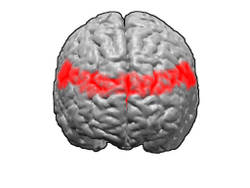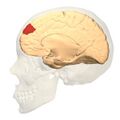Biology:Brodmann area 9
| Brodmann area 9 | |
|---|---|
 | |
 | |
| Details | |
| Identifiers | |
| Latin | Area frontalis granularis |
| Anatomical terms of neuroanatomy | |
Brodmann area 9, or BA9, refers to a cytoarchitecturally defined portion of the frontal cortex in the brain of humans and other primates. It contributes to the dorsolateral and medial prefrontal cortex.
Functions
The area is involved in short term memory,[1] evaluating recency,[2] overriding automatic responses,[3] verbal fluency,[4] error detection,[5] auditory verbal attention,[6] inferring the intention of others,[7] inferring deduction from spatial imagery,[8] inductive reasoning,[9] attributing intention,[10] sustained attention involved in counting a series of auditory stimuli,[11] and displays lower levels of energy consumption in individuals suffering from bipolar disorder.[12]
The area found on the left hemisphere is at least partially responsible for empathy,[13] idioms,[14][15] processing pleasant and unpleasant emotional scenes,[16] self criticisms[17] and attention to negative emotions.[18]
On the right hemisphere the region is involved in attributing intention,[19] theory of mind,[20] suppressing sadness,[21] working memory,[22][23][24] spatial memory,[25][26] recognition,[27][28][29] recall,[28][30][31] recognizing the emotions of others,[32] planning,[33] calculation,[34][35] semantic and perceptual processing of odors,[36] religiosity,[37] and attention to positive emotions.[18]
Guenon
Brodmann area 9 also exists in the frontal lobe of the guenon. Brodmann-1909 regarded it on the whole as topographically and cytoarchitecturally homologous to the granular frontal area 9 and frontopolar area 10 in the human. Distinctive features (Brodmann-1905): Unlike Brodmann area 6 (Brodmann-1909), area 9 has a distinct internal granular layer (IV); unlike Brodmann area 6 or Brodmann area 8 (Brodmann-1909), its internal pyramidal layer (V) is divisible into two sublayers, an outer layer 5a of densely distributed medium-size ganglion cells that partially merges with layer IV, and an inner, clearer, cell-poor layer 5b; the pyramidal cells of sublayer 3b of the external pyramidal layer (III) are smaller and sparser in distribution; the external granular layer (II) is narrow, with small numbers of sparsely distributed granule cells.[38]
Image
-
Animation.
-
front view.
-
Lateral view.
-
Medial view.
See also
References
- ↑ "Human cortical responses during one-bit delayed-response tasks: an fMRI study". Brain Research Bulletin 65 (5): 383–90. May 2005. doi:10.1016/j.brainresbull.2005.01.013. PMID 15833592.
- ↑ "Activation of the prefrontal cortex during judgments of recency: a functional MRI study". NeuroReport 7 (15–17): 2803–6. November 1996. doi:10.1097/00001756-199611040-00079. PMID 8981471.
- ↑ "Automaticity and reestablishment of executive control-an fMRI study". Journal of Cognitive Neuroscience 18 (8): 1331–42. August 2006. doi:10.1162/jocn.2006.18.8.1331. PMID 16859418.
- ↑ "Functional magnetic resonance imaging of verbal fluency and confrontation naming using compressed image acquisition to permit overt responses". Human Brain Mapping 20 (1): 29–40. September 2003. doi:10.1002/hbm.10126. PMID 12953304.
- ↑ "Dissociation of response inhibition and performance monitoring in the stop signal task using event-related fMRI". Human Brain Mapping 28 (12): 1347–58. December 2007. doi:10.1002/hbm.20355. PMID 17274022.
- ↑ "An FMRI study to investigate auditory attention: a model of the cocktail party phenomenon". Magnetic Resonance in Medical Sciences 4 (2): 75–82. 2005. doi:10.2463/mrms.4.75. PMID 16340161.
- ↑ "Modeling other minds". NeuroReport 6 (13): 1741–6. September 1995. doi:10.1097/00001756-199509000-00009. PMID 8541472.
- ↑ "Spatial imagery in deductive reasoning: a functional MRI study". Brain Research. Cognitive Brain Research 13 (2): 203–12. April 2002. doi:10.1016/S0926-6410(01)00116-1. PMID 11958963.
- ↑ "The seats of reason? An imaging study of deductive and inductive reasoning". NeuroReport 8 (5): 1305–10. March 1997. doi:10.1097/00001756-199703240-00049. PMID 9175134.
- ↑ "The neural consequences of conflict between intention and the senses". Brain 122 (3): 497–512. March 1999. doi:10.1093/brain/122.3.497. PMID 10094258.
- ↑ "The multiple dimensions of sustained attention". Cortex 44 (7): 794–805. 2008. doi:10.1016/j.cortex.2007.04.002. PMID 18489960.
- ↑ "Prefrontal and paralimbic metabolic dysregulation related to sustained attention in euthymic older adults with bipolar disorder". Bipolar Disorders 12 (8): 866–74. December 2010. doi:10.1111/j.1399-5618.2010.00881.x. PMID 21176034.
- ↑ "Investigating the functional anatomy of empathy and forgiveness". NeuroReport 12 (11): 2433–8. August 2001. doi:10.1097/00001756-200108080-00029. PMID 11496124.
- ↑ "Activation of left posterior cingulate gyrus by the auditory presentation of threat-related words: an fMRI study". Psychiatry Research 75 (1): 1–14. August 1997. doi:10.1016/s0925-4927(97)00018-8. PMID 9287369.
- ↑ "Idiom comprehension: a prefrontal task?". Cerebral Cortex 18 (1): 162–70. January 2008. doi:10.1093/cercor/bhm042. PMID 17490991.
- ↑ "Neuroanatomical correlates of pleasant and unpleasant emotion". Neuropsychologia 35 (11): 1437–44. November 1997. doi:10.1016/S0028-3932(97)00070-5. PMID 9352521.
- ↑ "Having a word with yourself: neural correlates of self-criticism and self-reassurance". NeuroImage 49 (2): 1849–56. January 2010. doi:10.1016/j.neuroimage.2009.09.019. PMID 19770047. https://publications.aston.ac.uk/id/eprint/16903/1/havingwordwithyourself.pdf.
- ↑ 18.0 18.1 "Abnormal prefrontal activity subserving attentional control of emotion in remitted depressed patients during a working memory task with emotional distracters". Psychological Medicine 42 (1): 29–40. January 2012. doi:10.1017/S0033291711001097. PMID 21733287.
- ↑ "A PET investigation of the attribution of intentions with a nonverbal task". NeuroImage 11 (2): 157–66. February 2000. doi:10.1006/nimg.1999.0525. PMID 10679187.
- ↑ "Imaging the intentional stance in a competitive game". NeuroImage 16 (3 Pt 1): 814–21. July 2002. doi:10.1006/nimg.2002.1117. PMID 12169265. https://pure.au.dk/ws/files/48455072/gallagher2002.pdf.
- ↑ "Cingulate cortex anatomical abnormalities in children and adolescents with bipolar disorder". The American Journal of Psychiatry 162 (9): 1637–43. September 2005. doi:10.1176/appi.ajp.162.9.1637. PMID 16135622.
- ↑ "Frontal activations associated with accessing and evaluating information in working memory: an fMRI study". NeuroImage 20 (3): 1531–9. November 2003. doi:10.1016/j.neuroimage.2003.07.016. PMID 14642465.
- ↑ "The neural system that bridges reward and cognition in humans: an fMRI study". Proceedings of the National Academy of Sciences of the United States of America 99 (8): 5669–74. April 2002. doi:10.1073/pnas.082111099. PMID 11960021. Bibcode: 2002PNAS...99.5669P.
- ↑ "Neuroimaging a single thought: dorsolateral PFC activity associated with refreshing just-activated information". NeuroImage 15 (2): 447–53. February 2002. doi:10.1006/nimg.2001.0983. PMID 11798278.
- ↑ "Prefrontal cortex hemispheric specialization for categorical and coordinate visual spatial memory". Neuropsychologia 44 (9): 1560–8. 2006. doi:10.1016/j.neuropsychologia.2006.01.018. PMID 16516248.
- ↑ "Sustained mnemonic response in the human middle frontal gyrus during on-line storage of spatial memoranda". Journal of Cognitive Neuroscience 14 (4): 659–71. May 2002. doi:10.1162/08989290260045882. PMID 12126506.
- ↑ "Prefrontal activity associated with working memory and episodic long-term memory". Neuropsychologia 41 (3): 378–89. 2003. doi:10.1016/S0028-3932(02)00169-0. PMID 12457762.
- ↑ 28.0 28.1 "Differential activation of the prefrontal cortex in successful and unsuccessful memory retrieval". Brain 119 (6): 2073–83. December 1996. doi:10.1093/brain/119.6.2073. PMID 9010011.
- ↑ "Positron emission tomography correlations in and beyond medial temporal lobes". Hippocampus 9 (1): 71–82. 1999. doi:10.1002/(SICI)1098-1063(1999)9:1<71::AID-HIPO8>3.0.CO;2-F. PMID 10088902.
- ↑ "Neuroanatomical correlates of retrieval in episodic memory: auditory sentence recognition". Proceedings of the National Academy of Sciences of the United States of America 91 (6): 2012–5. March 1994. doi:10.1073/pnas.91.6.2012. PMID 8134341. Bibcode: 1994PNAS...91.2012T.
- ↑ "Comparative electrophysiological and hemodynamic measures of neural activation during memory-retrieval". Human Brain Mapping 13 (2): 104–23. June 2001. doi:10.1002/hbm.1028. PMID 11346889.
- ↑ "Attentional modulation of emotional stimulus processing: an fMRI study using emotional expectancy". Human Brain Mapping 27 (8): 662–77. August 2006. doi:10.1002/hbm.20209. PMID 16317710.
- ↑ "Neural mechanisms of planning: a computational analysis using event-related fMRI". Proceedings of the National Academy of Sciences of the United States of America 99 (5): 3346–51. March 2002. doi:10.1073/pnas.052703399. PMID 11880658. Bibcode: 2002PNAS...99.3346F.
- ↑ "The fMRI study of the calculation tasks in normal aged volunteers" (in zh). Journal of Peking University 35 (3): 311–3. June 2003. PMID 12914254. http://xuebao.bjmu.edu.cn/fileup/PDF/200335311.pdf.
- ↑ "The calculating brain: an fMRI study". Neuropsychologia 38 (3): 325–35. 2000. doi:10.1016/S0028-3932(99)00068-8. PMID 10678698. https://zenodo.org/record/1259675.
- ↑ "Functional anatomy of perceptual and semantic processing for odors". Journal of Cognitive Neuroscience 11 (1): 94–109. January 1999. doi:10.1162/089892999563166. PMID 9950717.
- ↑ "Neural correlates of religious experience". The European Journal of Neuroscience 13 (8): 1649–52. April 2001. doi:10.1046/j.0953-816x.2001.01527.x. PMID 11328359.
- ↑
 This article incorporates text available under the CC BY 3.0 license.[unreliable source?] "BrainInfo". http://braininfo.rprc.washington.edu/centraldirectory.aspx?type=a&ID=1046.
This article incorporates text available under the CC BY 3.0 license.[unreliable source?] "BrainInfo". http://braininfo.rprc.washington.edu/centraldirectory.aspx?type=a&ID=1046.
External links
- Gusnard, Debra A.; Akbudak, Erbil; Shulman, Gordon L.; Raichle, Marcus E. (March 27, 2001). "Medial Prefrontal Cortex and Self-Referential Mental Activity: Relation to a Default Mode of Brain Function". Proceedings of the National Academy of Sciences of the United States of America 98 (7): 4259–64. doi:10.1073/pnas.071043098. PMID 11259662. Bibcode: 2001PNAS...98.4259G.
- https://web.archive.org/web/20141104204919/http://www.skiltopo.com/1/index.htm#BA9L[full citation needed]
- For Neuroanatomy of this area see BrainInfo
 |




